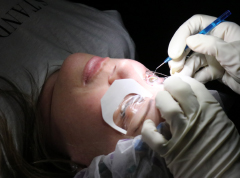MY PLIGHT FOR SIGHT
A Vision Tune-Up That’s Quick & Easy
I was not blessed with good vision and vividly remember getting my first pair of glasses after my teacher noticed I was straining to see the blackboard. She was right. After a visit to our family ophthalmologist, I remember the thrill I felt knowing I could have my very own pair of glasses, just like my mom and dad. I felt so lucky and happy until I wasn’t.
As I grew into adolescence, my eyes changed drastically. I went from having only to wear my glasses to read or watch TV to needing them all the time. Yes, I had my glasses. No, I would no longer wear them. I wouldn’t say I liked how I looked in them, and contacts were a nightmare for me. When wearing them, my eyes would tear up so much that people would insist I was crying.
THE FIRST TIME AROUND
And then there was the advent of LASIK laser vision. It was the late 1990s, and back then, the process was much more grueling than it is today. The procedure was more invasive, the downtime much longer, and the discomfort much higher. But I signed myself up and documented the process live on my news broadcast. In about a month, I had 20/20 vision and tossed my glasses.
Fast forward twenty-five years later, and my vision began to decline. It started slowly. First, I just needed glasses to drive at night. Then, I couldn’t recognize people’s faces or read menus on a wall without visual support. I missed the days of not squinting and appreciating the details and wanted that vision back. Having already gone through LASIK vision correction years before, I knew the drill, but I also learned a second procedure could be trickier. So, I sought the best. Dr. Jeff Dello Russo who’s the pinnacle for LASIK surgery in the U.S. After a thorough eye exam, which proved my theory of how fast my vision was declining as I approached 50 years, I learned that I would be able to correct my vision effectively.


IT’S TIME
About a week later, numbing drops were put into my eyes, and about 30 minutes later I was positioned with my head resting below lots of machines and lights, and drifted off to sleep. I felt absolutely nothing! The process took about fifteen minutes, and I was done!
This was a difference from my first round of LASIK. The process was closer to an hour for both eyes back then. I was fully awake, felt discomfort, and could not open my eyes for at least twenty-four hours post-surgery so that the healing process could effectively begin.
This was not the case this time around! I could see perfectly! Other than a little sore and scratchy, my eyes felt fine, and I went home in sunglasses to rest. Sunglasses are needed for the first day only, inside and outside, to ward off any sensitivity one may feel from light immediately post-procedure. The next morning, I went to work, where I spent the day on a computer.
A SAFE PROCEDURE
One of the most significant advancements in LASIK is the advent of improved tools used to cut the corneal flap. Historically the procedure was done with a microkeratome, a small mechanical blade. Now the flap is created with another laser instrument, the femtosecond IntraLase device, which yields much more comfort and less downtime. In addition, LASIK can now correct larger magnitudes of astigmatism, which glasses and contact lenses cannot. LASIK is far superior to SMILE refractive surgery, according to a recently published study in The Journal of Cataract and Refractive Surgery, to the trendy SMILE refractive surgery. In the survey, 80 patients underwent surgery; one eye with LASIK and one eye with SMILE, and 70 percent preferred the result of the eye treated with Lasik after 1-year post-op. LASIK treats all refractive errors, while SMILE only treats myopia, not farsightedness or astigmatism alone. Because LASIK has been around longer, it keeps advancing with time and tackling more vision impairments, creating a better quality of life!





